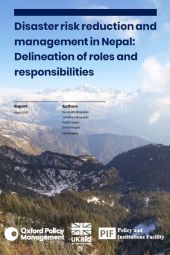Disaster Risk Reduction and Management in Nepal: Delineation of Roles and Responsibilities
Summary
This study depicts the outcomes of a review of concepts, policies, and practices through academic analysis and interdisciplinary reflections; consultations with 28 local government leaders and bureaucrats in Nepal about existing DRRM practices and capacities; and consultations with experts.
The existing constitutional and legislative provisions guiding DRRM authority in Nepal lack clarity regarding roles, responsibilities, and accountability at various government levels. The ambiguity extends to federal, provincial, and local governments, creating uncertainty on who is responsible for planning and implementing DRRM activities based on hazard nature, intensity, and scale. Acknowledging this gap, the DRRM National Council has tasked the MoHA with formulating a legal draft to delineate authority, responsibility, and accountability among these levels. To address this, the Policy and Institutions Facility, a component of DFID’s Disaster Resilience Programme, is providing technical assistance to conduct a study that considers jurisdictional mandates, practical issues, and universally accepted DRRM principles. The goal is to establish a basis for clarifying the roles of federal, provincial, and local governments in disaster management, responding to the call from the DRRM National Council.
Categories:
Report
Writer:
Dinanath Bhandari, Sanchita Neupane, Peter Hayes, Bimal Regmi, Phil Marker
Publisher:
Oxford Policy Management, UK Aid, Policy and Institutions Facility
Published Year:
2020
